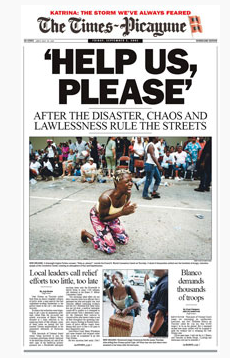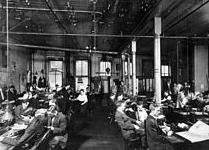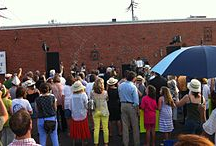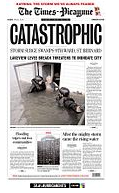
Times-Picayune
USINFO | 2013-07-02 15:12
| The Times-Picayune | |
 The September 2, 2005 front page of The Times-Picayune |
|
| Type | 3-days-a-week newspaper |
| Format | Broadsheet |
| Owner | Advance Publications |
| Publisher | Ricky Mathews |
| Editor | Jim Amoss |
| Founded | January 25, 1837 |
| ISSN | 1055-3053 |
| Official website | nola.com |
The Times-Picayune is a newspaper published in New Orleans, Louisiana, USA. Originally established in 1837 as The Picayune, it was a daily newspaper until the paper switched its print edition to three days a week, in the second half of 2012. The paper's final daily edition was printed Saturday, September 29, 2012.
The Times-Picayune funds the Edgar A. Poe Award for journalistic excellence, presented annually by the White House Correspondents' Association. The award is named for the newspaper's distinguished long-time national correspondent, Edgar Allan Poe.[1]
History

Established as The Picayune in 1837 by Francis Lumsden and George Wilkins Kendall, the paper's initial price was one picayune—a Spanish coin equivalent to 6¼¢ (1/16 $US).[2] Under Eliza Jane Nicholson, who inherited the struggling paper when her husband died in 1876, the Picayune introduced innovations such as society reporting (the "Society Bee" columns), children's pages and the first women's advice column, written by Dorothy Dix. Between 1880 and 1890, the paper more than tripled its circulation.[3] It became The Times-Picayune after merging in 1914 with its rival paper, the New Orleans Times-Democrat.[4]S.I. Newhouse bought the morning daily The Times-Picayune and the other remaining New Orleans daily, the afternoon States-Item, in 1962, and merged the papers in 1980. The merged paper was called The Times-Picayune/The States-Item from 1980 to 1986.[5] Specific community editions of the newspaper are also circulated and retain the Picayune name (e.g., Gretna Picayune for nearby Gretna). The paper is owned by Advance Publications, owned by the Newhouse family. In the vernacular of its circulation area the newspaper is often called the TP.
End of daily circulation and monopoly

On Thursday, May 24, 2012, Advance Publications announced that, beginning in fall 2012, the print edition of the Times-Picayune would be published three days a week (Wednesday, Friday, and Sunday).[6] A new company, NOLA Media Group, would continue providing news coverage on the paper's website.[7] The decision to stop daily circulation led to protests to continue publication for the "common good" with 50 local businesses writing an open letter to the owner-family to sell the paper instead since they had stated it was still profitable, and the formation of an ad hoc "Times-Picayune Citizens Group" of community institutions seeking alternatives.[8] The closure for a short time make New Orleans the largest U.S. city not to have a daily newspaper,[9] until The Advocate of Baton Rouge began publishing a New Orleans edition each day to fill the perceived gap. Meanwhile, three Advance papers in nearby Alabama also reduced publication to three times per week. On June 12, Advance followed through with its layoff plans, as about 200 Times-Picayune employees (including almost half of the newsroom staff) were notified that they would lose their jobs.[10] As of May 2013 the promised on-line site was reportedly of low quality as the newspaper struggled to compete with The Advocate's New Orleans edition by publishing a news stand only tabloid edition.[11]
Famous people
The writers William Faulkner and O. Henry worked for the paper. The Louisiana historian Sue Eakin was formerly a Times-Picayune columnist.[12]
The paper was awarded a 1997 Pulitzer Prize for a series analyzing the threatened global fish supply; that same year staff cartoonist Walt Handelsman was awarded the Pulitzer Prize for Editorial Cartooning. For its coverage of Hurricane Katrina, the paper received the 2005 George Polk Award for Metropolitan Reporting,[13] as well as a pair of 2006 Pulitzer Prizes. The Times-Picayune is also the journalistic home of British-Americansatiric columnist James Gill. The Times-Picayune has primary publishing rights for James Gill's columns.
Editorial stance
The paper's editorial stance is moderate to conservative, depending on the subject. It generally endorses Republicans in state and federal elections.[14] It endorsed George W. Bush for president in 2000, but endorsed no presidential candidate in 2004. In 2008, the paper endorsed DemocratBarack Obama for president.[15] In gubernatorial contests it endorsed Mike Foster and later Bobby Jindal. In the mayoral race of 2006, The Times-Picayune endorsed right-leaning DemocratRon Forman in the primary election and Lieutenant GovernorMitch Landrieu in the runoff.
The Times-Picayune is a predictable opponent of the State of Louisiana's high homestead exemption, which is phenomenally popular in suburban Jefferson Parish where it was championed by longtime assessor Lawrence Chehardy and his family and their political friends. In those areas an endorsement by the Picayune can have the effect of the "kiss of death" but does nothing to blunt the newspaper's circulation in the political mix of Louisiana. Through careful business practices, focused editions for certain suburban and outlying Louisiana parishes, ability to attract advertising, frugality, excellent writers and photographers such as Ted Jackson,[16] and other attributes The Times-Picayune has enjoyed a virtual monopoly on daily print journalism in New Orleans since 1962, long before the merger of other U.S. metropolitan dailies elsewhere.
Hurricane Katrina
Hurricane Katrina became a significant part of the history of The Times-Picayune not only during the storm and its immediate aftermath but for years afterward in repercussions and editorials.
Storm damage and interruption in printing
As Hurricane Katrina approached on Sunday, August 28, 2005 dozens of the newspaper's staffers who opted not to evacuate rode out the storm in the center of the building housing the newspaper, sleeping in sleeping bags and on air mattresses. Holed up in a small, sweltering back room called the "Hurricane Bunker," the newspaper staffers and staffers from affiliated web site "nola.com" posted continual updates on the internet all the way up until the time the building was evacuated on August 30. With the presses out of commission in the rising storm, newspaper and web staffers produced a "newspaper" in electronic format.
On NOLA.com, meanwhile, tens of thousands of evacuated New Orleans and Gulf Coast residents began using the site's forums and blogs, posting pleas for help, offering aid, and directing rescuers. NOLA's nurturing of so-called citizen journalism on a massive scale was hailed by many journalism experts as a watershed, while a number of agencies credited the site with leading to life-saving rescues and reunions of scattered victims in the days and months after the storm.

After deciding to evacuate Tuesday, August 30, because of rising floodwaters and possible security threats, the newspaper and web staff set up operations in Baton Rouge, on the Louisiana State University campus. A small team of reporters and photographers volunteered to stay behind in New Orleans to report from the inside on the city's struggle, looting, and desperation. They armed themselves for security and worked out of a private residence.
The August 30, August 31, and September 1, 2005 editions were not printed, but were available as PDFs online, as was the paper's breaking news weblog.
Hurricane Katrina struck metropolitan New Orleans on Monday with a staggering blow, far surpassing Hurricane Betsy, the landmark disaster of an earlier generation. The storm flooded huge swaths of the city, as well as Slidell on the north shore of Lake Pontchartrain, in a process that appeared to be spreading even as night fell.[17]
After three days of online-only publication, the paper began printing again.
In a January 14, 2006 address to the American Bar Association's Communications Lawyers Forum, Times-Picayune editor Jim Amoss commented on perhaps the greatest challenge that the staff faced then, and continued to face as the future of New Orleans is contemplated:
For us, Katrina is and will be a defining moment of our lives, a story we'll be telling till the day we die. Being a part of the plot is both riveting and deeply unsettling. We don't yet know the end of this story ... It's the story of our lives, and we must both live and chronicle it.[18]
Pulitzer Prizes
The paper shared the 2006 Pulitzer Prize for public service with The Sun Herald in similarly-affected Biloxi, Mississippi. In addition, staff reporters Doug MacCash, Manuel Torres, Trymaine Lee, and Mark Schleifstein were awarded a Pulitzer for breaking news reporting. [19] This award marked the first Pulitzer given for exclusively-online journalism.[20] Former Times-Picayune editorial cartoonist Mike Luckovich won the Pulitzer for his cartoons in The Atlanta Journal-Constitution, some of which were also featured in New Orleans Magazine.
Ongoing criticism of FEMA
As soon as possible after The Times-Picayune was able to restart publication after Katrina, the newspaper printed a strongly worded open letter to President George W. Bush in its September 4, 2005, edition, criticizing him for the federal government's response to Hurricane Katrina and calling for the firing of Federal Emergency Management Agency (FEMA) chief Michael D. Brown. Brown tendered his resignation eight days later.
The post-Katrina experience affected the paper's staff. On August 8, 2006, staff photographer John McCusker was arrested and hospitalized after he led police on a high-speed chase and then used his vehicle as a weapon, apparently hoping that they would kill him.[21]McCusker was released from the hospital by mid-August, saying he could not recall the incident at all, which was apparently sparked by the failure to receive an insurance settlement for his damaged house. He will still face criminal charges. The episode led to the establishment of a support fund for McCusker and for other Times-Picayune staff, which collected some $200,000 in just a few days.[22] In October, columnist Chris Rose admitted to seeking treatment for clinical depression after a year of "crying jags" and other emotionally isolating behavior.[23]
The Times-Picayune long continued to editorialize on FEMA.[24] A searing editorial on April 18, 2009, lambasted FEMA and labeled "insulting" the alleged "attitude" of its spokesman Andrew Thomas[25] toward people who were cash-strapped after the evacuation" from Hurricane Gustav, which in the meantime had become part of the melange of problems associated with hurricanes and governmental agencies; a second editorial on the same day blasted the State of Louisiana's Road Home program and its contractor ICF.[26]
Share this page



















